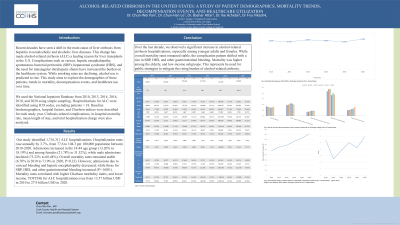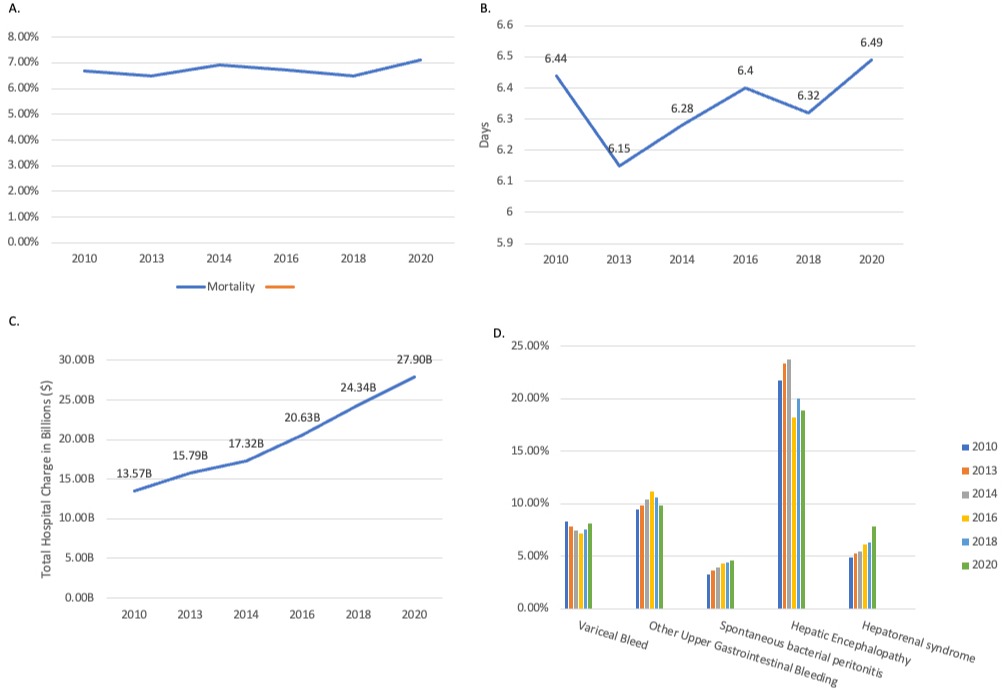Tuesday Poster Session
Category: Liver
P3769 - Alcohol-Related Cirrhosis in the United States: A Study of Patient Demographics, Mortality Trends, Decompensation Events, and Healthcare Utilization
Tuesday, October 24, 2023
10:30 AM - 4:00 PM PT
Location: Exhibit Hall

- CP
Chun-Wei Pan, MD
John H. Stroger, Jr. Hospital of Cook County
Chicago, IL
Presenting Author(s)
Chun-Wei Pan, MD1, Chun-Han Lo, MD, MPH2, Bashar Attar, MD3, Ike Achebe, MD4, Fnu Vikash, MD5
1John H. Stroger, Jr. Hospital of Cook County, Chicago, IL; 2Kirk Kerkorian School of Medicine at UNLV, Las Vegas, NV; 3Cook County Health, Chicago, IL; 4University of Massachusetts Chan Medical School, Worcester, MA; 5Jacobi Medical Center, Albert Einstein College of Medicine, Bronx, NY
Introduction: Recent decades have seen a shift in the main cause of liver cirrhosis from hepatitis to nonalcoholic and alcoholic liver diseases. This change has made alcohol-related cirrhosis (ALC) a leading reason for liver transplants in the U.S. Complications such as varices, hepatic encephalopathy, spontaneous bacterial peritonitis (SBP), hepatorenal syndrome (HRS), and the need for transjugular intrahepatic shunts have increased the burden on the healthcare system. While smoking rates are declining, alcohol use is predicted to rise. This study aims to explore the demographics of these patients, trends in mortality, decompensation events, and healthcare use over time.
Methods: We used the National Inpatient Database from 2010, 2013, 2014, 2016, 2018, and 2020 using simple sampling. Hospitalizations for ALC were identified using ICD codes, excluding patients < 18. Baseline biodemographics, hospital factors, and Charlson indices were described for each study year. Cirrhosis-related complications, in-hospital mortality rate, mean length of stay, and total hospitalization charge were also analyzed.
Results: Our study identified 1,716,311 ALC hospitalizations. Hospitalization rates rose annually by 3.7%, from 77.6 to 104.3 per 100,000 population between 2010-2020. Admissions increased in the 18-44 age group (13.20% to 18.19%) and among females (21.78% to 31.52%), while male admissions declined (73.22% to 68.48%). Overall mortality rates remained stable (6.70% in 2010 to 7.10% in 2020, P=0.33). However, admissions due to variceal bleeding and hepatic encephalopathy decreased, while those for SBP, HRS, and other gastrointestinal bleeding increased (P< 0.001). Mortality rates correlated with higher Charlson morbidity index, and lower income. TOTCHG for ALC hospitalizations rose from 13.57 billion USD in 2010 to 27.9 billion USD in 2020.
Discussion: Over the last decade, we observed a significant increase in alcohol-related cirrhosis hospitalizations, especially among younger adults and females. While overall mortality rates remained stable, the complication pattern shifted with a rise in SBP, HRS, and other gastrointestinal bleeding. Mortality was higher among the elderly, and low-income subgroups. This represents he need for public strategies to mitigate the rising burden of alcohol-related cirrhosis.

Disclosures:
Chun-Wei Pan, MD1, Chun-Han Lo, MD, MPH2, Bashar Attar, MD3, Ike Achebe, MD4, Fnu Vikash, MD5. P3769 - Alcohol-Related Cirrhosis in the United States: A Study of Patient Demographics, Mortality Trends, Decompensation Events, and Healthcare Utilization, ACG 2023 Annual Scientific Meeting Abstracts. Vancouver, BC, Canada: American College of Gastroenterology.
1John H. Stroger, Jr. Hospital of Cook County, Chicago, IL; 2Kirk Kerkorian School of Medicine at UNLV, Las Vegas, NV; 3Cook County Health, Chicago, IL; 4University of Massachusetts Chan Medical School, Worcester, MA; 5Jacobi Medical Center, Albert Einstein College of Medicine, Bronx, NY
Introduction: Recent decades have seen a shift in the main cause of liver cirrhosis from hepatitis to nonalcoholic and alcoholic liver diseases. This change has made alcohol-related cirrhosis (ALC) a leading reason for liver transplants in the U.S. Complications such as varices, hepatic encephalopathy, spontaneous bacterial peritonitis (SBP), hepatorenal syndrome (HRS), and the need for transjugular intrahepatic shunts have increased the burden on the healthcare system. While smoking rates are declining, alcohol use is predicted to rise. This study aims to explore the demographics of these patients, trends in mortality, decompensation events, and healthcare use over time.
Methods: We used the National Inpatient Database from 2010, 2013, 2014, 2016, 2018, and 2020 using simple sampling. Hospitalizations for ALC were identified using ICD codes, excluding patients < 18. Baseline biodemographics, hospital factors, and Charlson indices were described for each study year. Cirrhosis-related complications, in-hospital mortality rate, mean length of stay, and total hospitalization charge were also analyzed.
Results: Our study identified 1,716,311 ALC hospitalizations. Hospitalization rates rose annually by 3.7%, from 77.6 to 104.3 per 100,000 population between 2010-2020. Admissions increased in the 18-44 age group (13.20% to 18.19%) and among females (21.78% to 31.52%), while male admissions declined (73.22% to 68.48%). Overall mortality rates remained stable (6.70% in 2010 to 7.10% in 2020, P=0.33). However, admissions due to variceal bleeding and hepatic encephalopathy decreased, while those for SBP, HRS, and other gastrointestinal bleeding increased (P< 0.001). Mortality rates correlated with higher Charlson morbidity index, and lower income. TOTCHG for ALC hospitalizations rose from 13.57 billion USD in 2010 to 27.9 billion USD in 2020.
Discussion: Over the last decade, we observed a significant increase in alcohol-related cirrhosis hospitalizations, especially among younger adults and females. While overall mortality rates remained stable, the complication pattern shifted with a rise in SBP, HRS, and other gastrointestinal bleeding. Mortality was higher among the elderly, and low-income subgroups. This represents he need for public strategies to mitigate the rising burden of alcohol-related cirrhosis.

Figure: A. Mortality Rate between 2010-2020 B. Mean Length of Stay between 2010-2020 C. Inflation-adjusted total hospital charge between 2010-2020 D.Cirrohosis-related complication events between 2010-2020
Disclosures:
Chun-Wei Pan indicated no relevant financial relationships.
Chun-Han Lo indicated no relevant financial relationships.
Bashar Attar indicated no relevant financial relationships.
Ike Achebe indicated no relevant financial relationships.
Fnu Vikash indicated no relevant financial relationships.
Chun-Wei Pan, MD1, Chun-Han Lo, MD, MPH2, Bashar Attar, MD3, Ike Achebe, MD4, Fnu Vikash, MD5. P3769 - Alcohol-Related Cirrhosis in the United States: A Study of Patient Demographics, Mortality Trends, Decompensation Events, and Healthcare Utilization, ACG 2023 Annual Scientific Meeting Abstracts. Vancouver, BC, Canada: American College of Gastroenterology.
